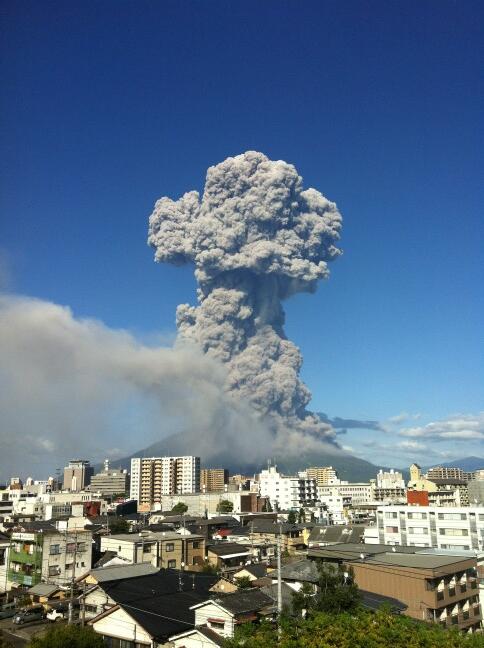
When it comes to terrifying displays of the power of Mother Nature, Japan never fails to deliver. These incredible photos capture the volcanic eruption off the coast of Kyuushu yesterday afternoon.
At 4:31 in the afternoon on August 18, the calm of Japan’s southernmost main island was shattered when the volcano of Sakurajima, in Kagoshima Prefecture, erupted.
The smoke from the explosion billowed up to 5,000 meters, the highest on record from the Showa crater. There were several small-scale pyroclastic flows (extremely fast-moving currents of hot gas and rocks) which traveled around 1 kilometre to the South East. These can have devastating consequences, but luckily the area around the volcano is uninhabited.
Kagoshima City turned dark as the cloud from the explosion blocked out the sun and ash rained down upon the city. The ash continued to fall for over an hour, and residents are continuing to wear masks as a precaution.
Visibility was compromised, causing delays on the trains and misery for tourists trying to make their way home at the end of Japan’s Obon summer holiday week. Part of the JR Nippō line that runs through Kagoshima Prefecture was shut down for nearly an hour and a half.
Sakurajima has several craters across its three peaks. According to the Kagoshima area meteorological observatory, the Showa crater on the southern peak (Minami-dake) erupted in 2006 after 58 years of inactivity, and has been relatively active since then. This is Sakurajima’s 500th eruption this year – what timing!
Professor Iguchi Masato of the Volcano Research Centre at the Disaster Prevention Research Centre of Kyoto University says “This is the biggest eruption from the Showa crater, however this does not immediately lead us to predict a further large-scale eruption.” The eruption warning level remains at 3 (restricted access).
Apparently, when compared to the huge eruption from the southern summit crater in 1914, this explosion is actually quite small-scale. The 1914 eruption was the biggest in twentieth century Japan, and resulted in significant changes to the landscape and tides of the area. It is estimated that smoke plumes at the time reached heights of 18,000 metres – over three times the scale of this one.
Yesterday’s eruption might be classified as “small-scale”, a mere belch next to the 1914 projectile vomit of lava and ash, but it still looks mighty impressive!
Source: Asahi Shinbun Digital
Images: HimaSoku, Twitter

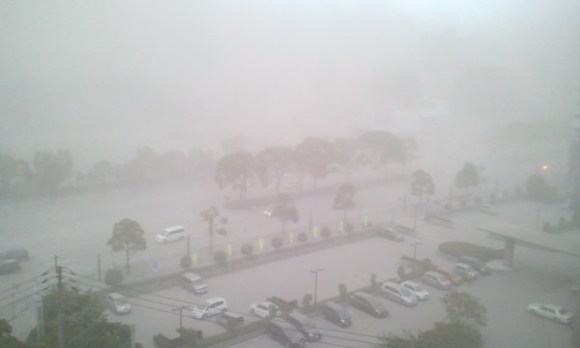
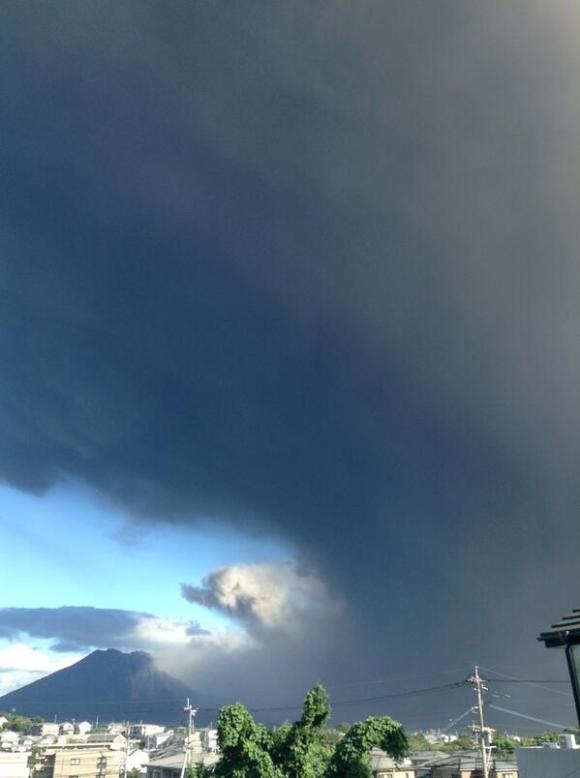

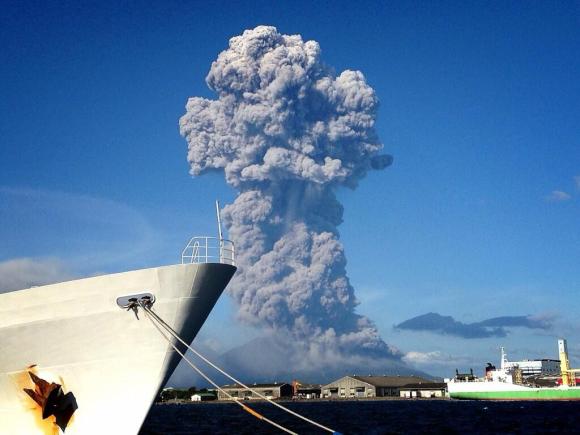
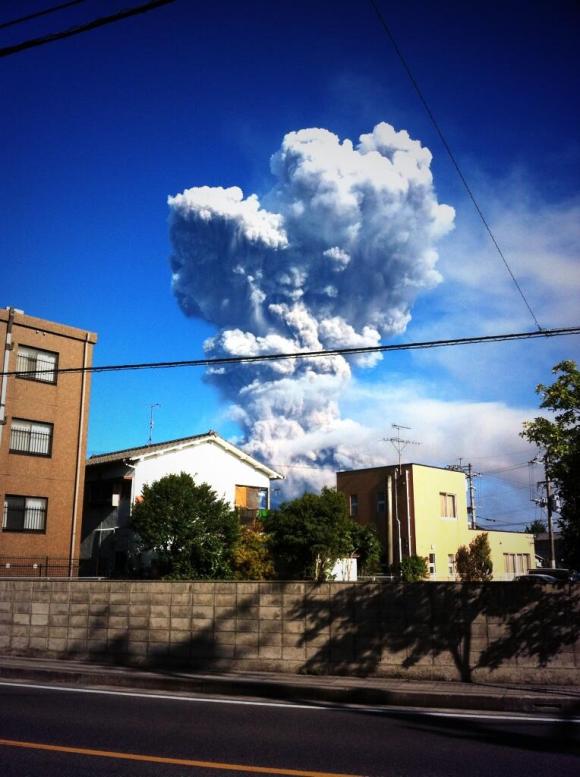
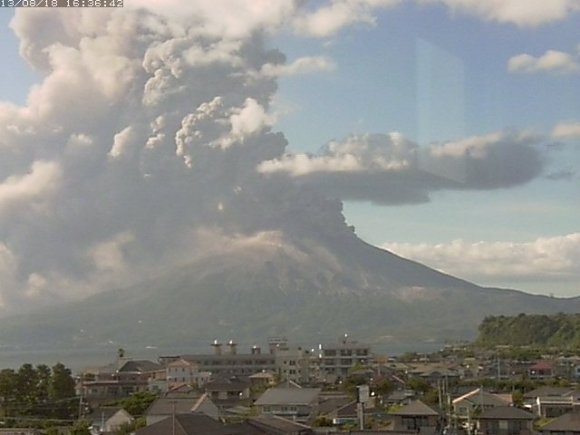
 Volcano Spawns Terrifying Tornado-Like Twisters【GIFS】
Volcano Spawns Terrifying Tornado-Like Twisters【GIFS】 Fiery balls of lava erupting from Nishinoshima eruption caught on video
Fiery balls of lava erupting from Nishinoshima eruption caught on video Japan’s Mt. Aso currently erupting, Kyushu residents capture dramatic photos
Japan’s Mt. Aso currently erupting, Kyushu residents capture dramatic photos Hakone volcano erupts on small scale
Hakone volcano erupts on small scale Geographical Survey Institute posts 184 images of Mount Ontake eruption online
Geographical Survey Institute posts 184 images of Mount Ontake eruption online Red light district sushi restaurant in Tokyo shows us just how wrong we were about it
Red light district sushi restaurant in Tokyo shows us just how wrong we were about it Japanese ramen restaurants under pressure from new yen banknotes
Japanese ramen restaurants under pressure from new yen banknotes Tokyo Tsukiji fish market site to be redeveloped with 50,000-seat stadium, hotel, shopping center
Tokyo Tsukiji fish market site to be redeveloped with 50,000-seat stadium, hotel, shopping center Beautiful Red and Blue Star luxury trains set to be Japan’s new Hokkaido travel stars
Beautiful Red and Blue Star luxury trains set to be Japan’s new Hokkaido travel stars McDonald’s new Happy Meals offer up cute and practical Sanrio lifestyle goods
McDonald’s new Happy Meals offer up cute and practical Sanrio lifestyle goods New private rooms on Tokaido Shinkansen change the way we travel from Tokyo to Kyoto
New private rooms on Tokaido Shinkansen change the way we travel from Tokyo to Kyoto French Fries Bread in Tokyo’s Shibuya becomes a hit on social media
French Fries Bread in Tokyo’s Shibuya becomes a hit on social media Pokémon Sleep camping suite and guestrooms coming to Tokyo Hyatt along with giant Snorlax burgers
Pokémon Sleep camping suite and guestrooms coming to Tokyo Hyatt along with giant Snorlax burgers Starbucks Japan adds a Motto Frappuccino to the menu for a limited time
Starbucks Japan adds a Motto Frappuccino to the menu for a limited time Sakura tree falls on man at Sannenzaka near Kiyomizu temple in Kyoto 【Breaking News】
Sakura tree falls on man at Sannenzaka near Kiyomizu temple in Kyoto 【Breaking News】 All-you-can-drink Starbucks and amazing views part of Tokyo’s new 170 meter-high sky lounge
All-you-can-drink Starbucks and amazing views part of Tokyo’s new 170 meter-high sky lounge More foreign tourists than ever before in history visited Japan last month
More foreign tourists than ever before in history visited Japan last month Studio Ghibli releases new action figures featuring Nausicaä of the Valley of the Wind characters
Studio Ghibli releases new action figures featuring Nausicaä of the Valley of the Wind characters Starbucks reopens at Shibuya Scramble Crossing with new look and design concept
Starbucks reopens at Shibuya Scramble Crossing with new look and design concept Studio Ghibli glasses cases let anime characters keep an eye on your spectacles
Studio Ghibli glasses cases let anime characters keep an eye on your spectacles Beautiful Ghibli sealing wax kits let you create accessories and elegant letter decorations【Pics】
Beautiful Ghibli sealing wax kits let you create accessories and elegant letter decorations【Pics】 Studio Ghibli releases Kiki’s Delivery Service chocolate cake pouches in Japan
Studio Ghibli releases Kiki’s Delivery Service chocolate cake pouches in Japan New definition of “Japanese whiskey” goes into effect to prevent fakes from fooling overseas buyers
New definition of “Japanese whiskey” goes into effect to prevent fakes from fooling overseas buyers Our Japanese reporter visits Costco in the U.S., finds super American and very Japanese things
Our Japanese reporter visits Costco in the U.S., finds super American and very Japanese things Studio Ghibli unveils Mother’s Day gift set that captures the love in My Neighbour Totoro
Studio Ghibli unveils Mother’s Day gift set that captures the love in My Neighbour Totoro New Japanese KitKat flavour stars Sanrio characters, including Hello Kitty
New Japanese KitKat flavour stars Sanrio characters, including Hello Kitty New Pokémon cakes let you eat your way through Pikachu and all the Eevee evolutions
New Pokémon cakes let you eat your way through Pikachu and all the Eevee evolutions Disney princesses get official manga makeovers for Manga Princess Cafe opening in Tokyo
Disney princesses get official manga makeovers for Manga Princess Cafe opening in Tokyo Sales of Japan’s most convenient train ticket/shopping payment cards suspended indefinitely
Sales of Japan’s most convenient train ticket/shopping payment cards suspended indefinitely Sold-out Studio Ghibli desktop humidifiers are back so Totoro can help you through the dry season
Sold-out Studio Ghibli desktop humidifiers are back so Totoro can help you through the dry season Japanese government to make first change to romanization spelling rules since the 1950s
Japanese government to make first change to romanization spelling rules since the 1950s Ghibli founders Toshio Suzuki and Hayao Miyazaki contribute to Japanese whisky Totoro label design
Ghibli founders Toshio Suzuki and Hayao Miyazaki contribute to Japanese whisky Totoro label design Doraemon found buried at sea as scene from 1993 anime becomes real life【Photos】
Doraemon found buried at sea as scene from 1993 anime becomes real life【Photos】 Tokyo’s most famous Starbucks is closed
Tokyo’s most famous Starbucks is closed One Piece characters’ nationalities revealed, but fans have mixed opinions
One Piece characters’ nationalities revealed, but fans have mixed opinions We asked a Uniqlo employee what four things we should buy and their suggestions didn’t disappoint
We asked a Uniqlo employee what four things we should buy and their suggestions didn’t disappoint Princesses, fruits, and blacksmiths: Study reveals the 30 most unusual family names in Japan
Princesses, fruits, and blacksmiths: Study reveals the 30 most unusual family names in Japan Mount Ontake: some hikers “died taking photos of the erupting volcano”, pathologist says
Mount Ontake: some hikers “died taking photos of the erupting volcano”, pathologist says Google Street View catches Russian bear in the middle of snacking on a salmon
Google Street View catches Russian bear in the middle of snacking on a salmon Do you dress like Tokyo or Osaka? Study creates one outfit for every Japanese prefecture
Do you dress like Tokyo or Osaka? Study creates one outfit for every Japanese prefecture Kagoshima City releases catchy promotional video with weird dancing, bushy eyebrows, no pants
Kagoshima City releases catchy promotional video with weird dancing, bushy eyebrows, no pants Mount Aso: I heard you like volcanoes, so I put some volcanoes in your volcano【Photos】
Mount Aso: I heard you like volcanoes, so I put some volcanoes in your volcano【Photos】 Go to hell: Unzen Hot Springs invites visitors to take an infernal stroll through a field of deadly hell-mouths
Go to hell: Unzen Hot Springs invites visitors to take an infernal stroll through a field of deadly hell-mouths Continuing earthquakes in Kumamoto have moved a GPS observation station nearly one meter
Continuing earthquakes in Kumamoto have moved a GPS observation station nearly one meter Mt Fuji looks unusual, sparks fears of possible eruption
Mt Fuji looks unusual, sparks fears of possible eruption Japan’s beautiful “suicide forest” sees increase in sightseers as it tries to shake its dark image
Japan’s beautiful “suicide forest” sees increase in sightseers as it tries to shake its dark image Japan’s most famous hot spring resort runs ad telling us to go to…a different hot spring resort
Japan’s most famous hot spring resort runs ad telling us to go to…a different hot spring resort Kirishima Geopark: Trekking through a bonsai forest in the clouds 【Photos】
Kirishima Geopark: Trekking through a bonsai forest in the clouds 【Photos】 Domino’s Japan’s New Cheese Volcano Pizza is a game-changer that’s about to go global
Domino’s Japan’s New Cheese Volcano Pizza is a game-changer that’s about to go global Couple in China get married under romantic rain of fire and brimstone【Video】
Couple in China get married under romantic rain of fire and brimstone【Video】 Godzilla is finally discovered in the ocean’s depths!
Godzilla is finally discovered in the ocean’s depths! Mount Fuji plans to start charging compulsory fee to climbers
Mount Fuji plans to start charging compulsory fee to climbers
Leave a Reply